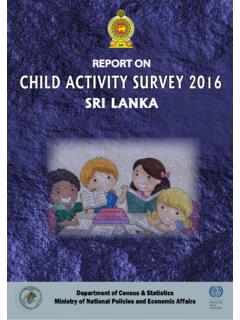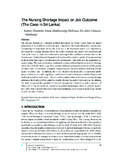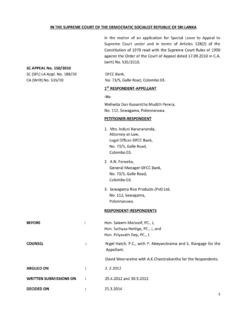Transcription of Annual Bulletin - 2016 - statistics.gov.lk
1 1 The economically active population or the labour force comprises all persons of working age who are either employed or unemployed during the reference period (The week before the survey period). Labour force = Employed + Unemployed Economically Active Population (Labour Force) In the past, information on labour force characteristics, employment and unemployment etc. were collected through labour force and socio - economic surveys conducted at five year time intervals. However, the employment and unemployment data are required at very short intervals to monitor the programmes implemented in the employment generating policies of the government.
2 Therefore, to satisfy this need, the Department of Census and Statistics (DCS) designed a labour force survey on a quarterly basis, to measure the levels and trends of employment, unemployment and labour force in Sri Lanka on a continuous basis. Hence, the survey was commenced from the first quarter of 1990 and is being continued by the DCS. This Bulletin is based on an Annual sample of 25,750 housing units covering all districts of the country. In 2016 the survey was conducted from January to December. Table : Labour Force participation rate by gender - 2016 Gender Economically active population (No.)
3 Labour Force Participation rate Total 8,310,682 Male 5,303,502 Female 3,007,180 Table : Distribution of economically active / inactive population by gender - 2016 Gender Economically active population Economically inactive population No. % No. % Total 8,310,682 7,137,997 Male 5,303,502 1,761,234 Female 3,007,180 5,376,764 Table : Percentage distribution of economically active population by gender & district 2016 District Economically active population (%) Total Male Female Total Colombo Gampaha Kalutara Kandy Matale Nuwara Eliya Galle Matara Hambantota Jaffna Mannar Vavunia Mullativu Kilinochchi Batticaloa Ampara Trincomalee Kurunegala Puttalam Anuradhapura Polonnaruwa Badulla Moneragala Ratnapura Kegalle 1.
4 LABOUR FORCE: HIGHLIGHTS - 2016 S ri L a n k a L a b o u r F o rc e S u rv e y Department of Census and Statistics Ministry of National Policies and Economic Affairs Annual Bulletin - 2016 Working Age Population All persons above specific age limit (15 years and above) of either gender are identified as working age population. This population consists with two groups namely economically active & inactive. Reported labour force participation rate is in 2016 (Table ). Given the estimated counts in Table in 2016, estimated economically active population is around million.
5 About million ( ) of economically active population are males. Economically inactive population accounts for about million and of that majority are females ( ). 2 Table : Employment statistics by gender - 2016 Table : Percentage distribution of employed population by major industry group, Sector, Province and District - 2016 Table : Percentage distribution of employed population by employment status & gender - 2016 Employment status Total Gender Male Female Total Employee Employer Own account worker Contributing family worker Employment Statistic Sri Lanka Male Female Employed population 7,947,683 5,149,948 2,797,735 Labour Force 8,310,682 5,303,502 3,007,180 Employment rate 2.
6 EMPLOYMENT: HIGHLIGHTS - 2016 Employed: During the reference period, persons, who worked as paid employees, employers, own account workers or contributing family workers are said to be employed. This also includes persons with a job but not at work during the reference period. Figure : Percentage distribution of employment status by gender 2016 account workerContributing familyworkerMaleFemale District Total Major Industry Group Agri. Ind. Serv. Colombo Gampaha Kalutara Kandy Matale Nuwara Eliya Galle Matara Hambantota Batticaloa Ampara Trincomalee Jaffna Mannar Vavunia Mulativu Kilinochchi Kurunegala Puttalam Anuradhapura Polonnaruwa Badulla Monaragala Rathnapura Kegalle Sector/Province Total Major Industry Group Agri.
7 Ind. Serv. Sri Lanka Urban Rural Estate Province Western Central Southern Northern Eastern North Western North Central Uva Sabaragamuwa Agri. - Agriculture sector, Ind. - Industries sector, Serv. - Service sector 3 Table : Unemployment rates by age groups and gender - 2016 Age group (Years) Total Gender Male Female Total 15 - 24 25 - 29 30 - 39 Over 40 The unemployed population, reported in 2016 is 362,999.
8 Survey reports that overall unemployment for males and female are percent & percent respectively. Among all age groups, unemployment rates of females are higher than those of males. Youth unemployment (age 15 24 years) rates are the highest for both sexes, compared to other age groups (Table ). Table : Unemployment Rates by level of education & gender 2016 Level of Education Total Gender Male Female Total Grade10 & below (O/L) (A/L) & above According to the Table , when level of education is considered the highest unemployment rate ( ) is reported from the (A/L) & above group.
9 It is percent and percent for male and female respectively. Table and Table show the distribution of unemployment rates by sector, province & district respectively. When the provincial distribution considered the highest unemployment rate is reported from Northern province ( ). Female unemployment rates are higher compared to that of male in all provinces. When the district level distribution is considered the highest unemployment is reported from Matale District ( ) while the lowest rate is reported from Colombo. Table : Unemployment rates by gender, sector and province - 2016 Sector / Province Unemployment rate (%) Total Male Female Sri Lanka Sector Urban Rural Estate Province Western Central Southern Northern Eastern North Western North Central Uva Sabaragamuwa These figures are to be treated with caution as the corresponding CV (Coefficient of variation) values are high.
10 Table : Unemployment rates by district - 2016 District Unemp. rate (%) District Unemp. rate (%) Colombo Kilinochchi Gampaha Batticaloa Kalutara Ampara Kandy Trincomalee Matale Kurunegala Nuwara Eliya Puttalam Galle Anuradhapura Matara Polonnaruwa Hambantota Badulla Jaffna Monaragala Mannar Rathnapura Vavunia Kegalle Mullativu These figures are to be treated with caution as the corresponding CV (Coefficient of variation) values are high. Unemployed: Persons available and/or looking for work, and who did not work and taken steps to find a job during last four weeks and ready to accept a job given a work opportunity within next two weeks are said to be unemployed.













